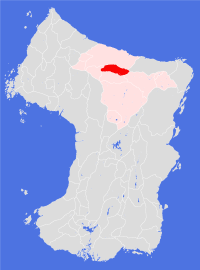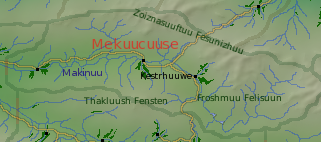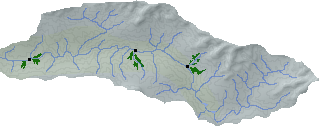Mekuucuuse

Societal ties: Ambostak
Current population: 1
Main language(s): Ramajal
Area: 120,000km²
Natural and political borders
The natural borders of Mekuucuuse are to the north the Zoiznasuuftuu Fesunizhuu and to the south the Thakluush Fensten. Neither range rises to a significant height; in the south east a traveler could pass from this Land into Rhindose without realising they'd crossed the watershed.
The Land controls all the waters of the Makinuu river east of longitude 171.5°E.
History
The lower reaches of the Makinuu river, up to the present site of Kestrhuuwe, were originally mapped out by Behrl Groman in gt675. The temple authorities established the first settlement in the valley in gt710, with a second further upriver in gt721. Kestrhuuwe settlement was established in gt729.
From the outset, these settlements were designed as temple retreats and teaching settlements; permanent settlers were discouraged in favour of fixed-term settlement - individuals would come to the settlements for between 3 and 5 orbits to teach and to learn about the more spiritual aspects of temple theology - for instance the western settlement was maintained as a mostly male environment while the central settlement was restricted mainly to women. The extension of the railway across the valley in gt767 led to an influx of permanent settlers who joined the existing community of temple elders who had chosen to retire in the valley.
On midsummer day gt796, in a dramatic move, the temple authority moved its headquarters from the city of Ramaje to Kestrhuuwe - signaling its withdrawal from the political crisis which at that time was shaking the Ramane State. In gt799 Mekuucuuse became an independent Land as part of the Treaty of Kestrhuuwe.
Following the demise of the Ramane State, Kestrhuuwe settlement assumed a new importance in the political and social milieu of Ambostak Society - though the settlement itself only grew slowly. In gt826 the settlement hosted the first Ambostak congress - a semi-official gathering of key statesmen and policy makers from across the Ambostak Lands (and more recently from further afield); the second congress was held in gt829 and has been held every three orbits since then.

Politics and economy
Since its inception, the Land has operated as a hierarchical theocracy, though the temple authorities have always encouraged debate and civil dispute within its ranks as a way of progressing with contemporary developments in the wider world. Each settlement is autonomous, though major decisions need to be agreed between all three settlements before they can be enforced. Mekuucuuse is unique among Lands in that some policy decisions can only be made by the consent of the majority of all temple officials, most of whom reside in other Lands.
There is little economic activity beyond those sectors involved in the development and maintenance of the agricultural and building sectors. The Land remains a place of teaching, and over 15,000 of the people who live in the settlements are temporary residents.
Culture and other issues of interest
The religions of the three Cheidran Societies all share common roots dating back at least three millennia. The basic structure of Cheidran religion is the belief in the Goddess and the God, who represent the animate forces of Type One and Type Two lifeforms respectively. Both are considered to be self-created entities, and the product of their liaison is the planet. Both are considered to be essential to the sustenance of all life in all of its various forms.
The development of religious belief across the continent of Cheidrah varied according to region: the western areas (now the Ambostak and Bartak Societies) developed a series of stories in which conversations between the God and Goddess led to the formation of various physical features on the planet, leading to a very cerebral - almost scientific - theology dedicated to interpreting these conversations and honouring their consequences; while in the east of the continent there developed a more humanistic form of worship in which the Goddess gave birth to a daughter and a son (the Queen of Chein and the Prince of Storms) who took physical form and ruled the first world for a thousand orbits before being killed by her own children - the Kumatti religion, for instance, gives far more promenance to the Queen and Prince than to the God and Goddess. In the south of Cheidrah the religion was more superstitious with the God and Goddess producing numerous children - the Archetypes - who came to represent different animals, plants and human tribes. These produced a series of (often conflicting) stories and practices which are widespread throughout the Pentuuk Society.
Of all the active religions based on Cheidran beliefs, the Ambostak temple is the largest and the most cohesive. The temple has a hierarchical nature because the world is viewed as a hierarchical structure, with complexity emanating from the interaction of well defined laws and functions. At the top of the hierarchy are two people, a man and a woman, who are symbolically married in a united leadership known as the Listeners. Beneath them are the heads of a number of temple schools - which can in some ways be thought of as trade guilds and geographically based associations, who control the day-to-day running of the temple's many activities.
All settlements across the Ambostak Lands will have a temple, as will the neighbourhoods of larger settlements and cities. Extended families, too, may have a temple as may business partnerships and large businesses. The 'temple' is in fact a token of the God and Goddess - an artifact that can take many forms - blessed by the Listeners and commissioned to act as a central point for worship and discussion, though when people talk of the local temple they usually mean the building where the temple artifact is kept rather than the artifact itself.
Key natural features
While few people would claim that there are any outstanding natural features in Mekuucuuse - Mt. Ghelosuu, in the Zoiznasuuftuu Fesunizhuu only rises to 2,260m above current sea levels - the rolling hills of the Makinuu valley are considered beautiful by many.

Habitats
The Makinuu valley is host to a northern valleys habitat, surrounded by a northern scrublands habitat at the higher elevations.
Plantations and settlements
There are three settlements along the western half of the valley; Kestrhuuwe is the easternmost of these, and the largest; it is the seat of the Ambostak temple headquarters. Small seasonal camps can be found to the east in the Froshmuu Felisuun; the temple authorities have recently announced that they intend to establish a new settlement in the east, though no site has yet been selected.
Key towns and cities
Rural population: 0 (0.0% of total)